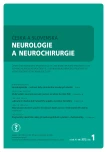Fiber Dissection Technique of the Tracts of the Lateral Aspects of the Hemisphere
Authors:
R. Bartoš 1; A. Hejčl 1; A. Zolal 1; A. Malucelli 1; M. Sameš 1; P. Petrovický 2
Authors‘ workplace:
Neurochirurgická klinika UJEP a Krajská zdravotní, a. s. – Masarykova nemocnice v Ústí nad Labem, o. z., a Neuroanatomická laboratoř UJEP v Ústí nad Labem
1; Anatomický ústav 1. LF UK v Praze
2
Published in:
Cesk Slov Neurol N 2012; 75/108(1): 30-37
Category:
Original Paper
Overview
Aim:
The aim of our study was to elucidate the individual fiber tracts courses of the lateral aspect of the hemisphere and documentation of their position relative to each other and also relative to other brain structures. We present a simple manual for the technique of dissection of the subcortical areas.
Materials and methods:
Using the Joseph Klingler’s technique consisting of freezing the formalin-fixed brain, we prepared and consequently performed the laboratory microdissection on six hemispheres. We documented the results with microand macrophotographs and correlated the course of the individual tracts with the results of DTI-tractography in a healthy volunteer.
Results:
Using the dissection technique, we documented the anatomy of the insula, lateral lenticulostriate perforating arteries, superior and inferior longitudinal fascicle, occipitofrontal, uncinate, claustrocortical connections in the external capsule, anterior commissure and internal capsule. All of these tracts, excluding the inferior longitudinal fascicle, which is hardly separable from the geniculocalcarine tract, are clearly and illustrativelly identifiable by the fiber dissection technique.
Conclusion:
The described dissection technique represents a practical educational tool; it enables neurosurgeon to understand the complexity of brain functional connections and should be accessible to all neurosurgery residents.
Key words:
anatomy – cortex – white matter tracts – fiber dissection technique – tractography
Sources
1. Klingler J. Erleichterung der makroskopischen Praeparation des Gehirns durch den Gefrierprozess. Schweiz Arch Neurol Psychiatr 1935; 36 : 247–256.
2. Türe U, Yaşargil MG, Al-Mefty O, Yaşargil DC. Topographic anatomy of the insular region. J Neurosurg 1999; 90(4): 720–733.
3. Türe U, Yaşargil MG, Al-Mefty O, Yaşargil DC. Arteries of the insula. J Neurosurg 2000; 92(4): 676–687.
4. Fernández-Miranda JC, Rhoton AL, Alvarez-Linera J, Kakizawa Y, Choi Ch, de Oliviera EP. Three-dimensional Microsurgical and Tractographic Anatomy of the White Matter of the Human Brain. Neurosurgery 2008; 62 (6 Suppl 3): 989–1028.
5. Türe U, Yaşargil MG, Friedman AH, Al-Mefty O. Fiber dissection technique: lateral aspect of the brain. Neurosurgery 2000; 47(2): 417–426.
6. Borovanský L et al. Soustavná anatomie člověka. 2. díl. Praha: Avicenum 1976.
7. Petrovický P et al. Klinická neuroanatomie CNS s aplikovanou neurologií a neurochirurgií. Praha/Kroměříž: Triton 2008 : 274–277.
8. Lichtheim L. On aphasia. Brain 1884; 7 : 433–484.
9. McCarthy R, Warrington E. A teo-route model of speech production. Brain 1984; 107(2): 463–485.
10. Catani M, Jones DK, Ffytche DH. Perisylvian language networks of the human brain. Ann Neurol 2005; 57(1): 8–16.
11. Duffau H, Gatignol P, Mandonnet E, Peruzzi P, Tzourio-Mazoyer N, Capelle L. New insights into the anatomo-functional connectivity of the semantic system: a study using cortico-subcortical electrostimulations. Brain 2005; 128(4):797–810
12. Schmahmann JD, Pandya DN. Fiber Pathways of the Brain. New York: Oxford University Press 2006.
13. Türe U, Yaşargil MG, Pait T, Glenn MD. Is there a superior occipitofrontal fasciculus? A microsurgical anatomic study. Neurosurgery 1997; 40(6): 1226–1232.
14. Tusa RJ, Ungerleider LG. The inferior longitudinal fasciculus: a reexamination in humans and monkeys. Ann Neurol 1985; 18(5): 583–591.
15. Catani M, Jones DK, Donato R, Ffytche DH. Occipito - temporal connections in the human brain. Brain 2003; 126(9): 2093–2107.
16. Wilson CL, Babb TL, Halgren E, Crandall PH. Visual receptive fields and response properties of neurons in human temporal lobe and visual pathways. Brain 1983; 106(2): 473–502.
17. Fernández-Miranda JC, Rhoton AL, Kakizawa Y, Choi C, Alvarez-Linera J. The claustrum and its projection system in the human brain: a microsurgical and tractographic anatomical study. J Neurosurg 2008; 108(4): 764–774.
18. Druga R. Claustro-cortical connections in the cat and rat demonstrated by HRP tracking technique. J Hirnforsch 1982; 23(2): 191–202.
19. Crick FC, Koch C. What is the function of the claustrum? Philos Trans R Soc Lond B Biol Sci 2005; 360(1458): 1271–1279.
20. Duffau H, Mandonnet E, Gatignol P, Vapelle L. Functional compensation of the claustrum: lessons from the low-grade glioma surgery. J Neuroncol 2007; 81(3): 327–329.
21. Kimura S, Nezu A, Osaka H, Saito K. Symmetrical external capsule lesions in a patient with herpes simplex encephalitis. Neuropediatrics 1994; 25(3): 162–164.
22. Rimrodt SL, Peterson DJ, Denckla MB, Kaufmann WE, Cutting LE. White matter microstructural differences linked to left perisylvian language network in children with dyslexia. Cortex 2010; 46(6): 739–749
Labels
Paediatric neurology Neurosurgery NeurologyArticle was published in
Czech and Slovak Neurology and Neurosurgery

2012 Issue 1
- Metamizole vs. Tramadol in Postoperative Analgesia
- Memantine in Dementia Therapy – Current Findings and Possible Future Applications
- Advances in the Treatment of Myasthenia Gravis on the Horizon
- Hope Awakens with Early Diagnosis of Parkinson's Disease Based on Skin Odor
Most read in this issue
- Vertebroplasty – Treatment Option for Structurally Insufficient Vertebras
- Carpal Tunel Syndrome and Neurosurgeon – Experience after 2,200 Surgeries
- Guillain-Barré Syndrome in a Patient with a Renal Carcinoma – a Case Report
- Guidelines for Pharmacotherapy of Neuropathic Pain
